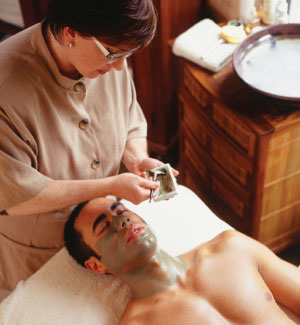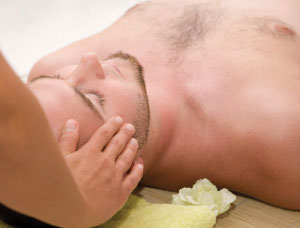There haven’t been too many topics capturing more attention recently than the growing male market in skin care and spas in general. Google the topic and you will be bombarded with nearly 47 million entries.
It’s interesting to pause for a moment to consider why there’s been such an explosion of information about men’s skin care and, along the same lines, such a surge in men’s participation in spas and interest in skin care. Perhaps it’s a bit of a chicken-or-the-egg dilemma: Is the increase in information prompted by men’s increased interest or vice-versa?
We are not aware of any specific research or studies that can provide a definitive answer to this question, but speculate that it’s a little of both. There’s little disputing that there’s been a shift in general notions of acceptable vanity for men over the past several years. Not only are men partaking in traditional facials, but trends show increased sales of non-invasive cosmetic procedures (think fillers and injectibles), as well as elective cosmetic surgery. Most of this new “vanity” stems from a male demographic that includes successful, middle-aged professionals driven to preserve a healthful appearance. We also suspect there’s ample blame for the fortunes spent on cosmetic surgery and men’s grooming to be placed upon George Clooney and the like who’ve placed the bar unreasonably high for mere male mortals.

With the American male grooming market estimated at now worth more than $11 billion, it’s worth pausing to consider how to best tap into the mentality driving this phenomenon. Like so many other issues, it starts with knowing your specific market, whether it’s your existing male client base or your desired male client base, and what it is you can offer them.
While there are endless market categories and sub-categories, we suggest that there are four primary pigeonholes that are useful in your strategizing the capture of your share of the men’s skin care land rush. These categories are Lifestyle, Luxury, Efficiency Driven, and Average Joe.
Of course, there are apt to be truisms applicable to all of these clusters. For example, most examining this field will agree that most men value simplicity in skin care regimens and that, regardless of categorization, anxieties about the effects of aging are strong motivators. Nevertheless, among these four clusters, there are some meaningful differences in the positioning strategies most likely to gain traction.
Lifestyle consumers are those whose decisions are driven by their quest to align purchases with their own core values. A key example of such a group is the Lifestyles of Health and Sustainability (LOHAS) consumers, for whom environmental, social, and healthy lifestyle values drive their purchase decisions. However, Lifestyle consumers may also include athletic-minded consumers or those focused on the arts or on travel. Advertising offers us endless examples of how various products are pitched specifically to harness the allure of enabling would-be purchasers to envision themselves being one step closer to living their dream through the simple step of purchasing the advertised product.
Skin care products and services targeted for Lifestyle male consumers should be positioned to align with your targeted market’s key drivers. If your market includes a significant portion of LOHAS consumers, for example, make certain that your featured product lines include ‘green’ and sustainable options and that your efforts to support socially-aware practices, such as buying local, are tastefully touted.
For athletically-minded consumers, golf fanatics for example, consider using the “preventative” or “protective” message and tailor your offerings to include skin care services and products designed to combat the effects of the wind and sun.
Male Luxury clients are affluent buyers that have disposable incomes and seek to boost the quality of their life by purchasing the best that money can buy. For these clients with high expectations, focus your offerings on tailored products and services emphasizing premium ingredients and exclusivity. Like the Lifestyle consumer, particularly the LOHAS consumer, product ingredient is more likely to be a critical consideration. Products that contain ingredients regarded as negative, inferior, or dubious, such as laurel sulfates and parabens, will be more closely scrutinized by these groups.
Drivers appealing to Efficiency Driven males relate to efficacious and highly results-driven and results-proven products and services. These pragmatic consumers are less influenced by flowery prose and more swayed by a direct pitch describing the critical path to optimal results. Product offerings for this group should support a simple skin care regimen and should feature demonstrable results, ideally backed by clinical research or other substantiating information. Similarly, service offerings should emphasize efficient delivery of specific results, such as a lunchtime cleansing facial. 
More high-tech skin care services, such as microdermabrasion or the heir-apparent microcurrent treatments are particularly suited to these Efficiency Driven males. Tout tangible results through these technical services, which can be delivered to meet an on-the-run schedule. Because of the heightened benefits from a series of treatments, microcurrent treatments are particularly suited to bundling into a series package with “express” time slots, allowing Efficiency Driven males to schedule their regimen into their packed calendars.
A broader category of male consumers is the Average Joe. Although this class arguably captures a larger segment of male consumers, it’s decidedly not at the forefront of participation in male skin care trends. Frequently, these consumers may be a bit aloof about their skin care, but with the right prompting are receptive to uncluttered, simple step skin care solutions. Like most of us, even the Average Joe has his vanities and will respond to the prospect of more attractive skin and lessening the ravages of the aging process on the skin. While the Average Joe may not be keenly focused on skin care, odds are his mate may be and will often be prompting his skin care initiation… perhaps through a gift certificate.
None of the above is meant to imply that you cannot target two or more of these four groups at the same time. In truth, some of the same products and services can appeal to most of these groups if correctly positioned. No matterhow effectively you present your case, there’ll always be a few holdout dinosaurs, insisting on using only bar soap to wash their face, rejecting moisturizers, and shunning sunscreens.
Careful consideration should be given to retail strategies, taking into account the distinct considerations of the male consumer categories we’ve described. Packaging must be aligned to attract your target market and your featured lines should have a manageable number of SKUs and should include travel kits.
A key to understanding the male skin care market is to understand that customization is just as relevant to the male market as it is to the female market. All too often, a spa menu features multiple facial options unmistakably crafted for women and a single one-size-fits-all facial for men. A more customized experience for men should be the goal, accommodating the individual needs and desires of your target male market.
 Doug Chambers, founder/principal of Blu Spas, Inc. alongside business partner Cary Collier, has been in the spa industry for more than 16 years. Blu Spas is an international spa design, consulting, and management company that has participated in over 250 innovative projects in 25 countries and has one of the most respected portfolios of any consulting firm in the industry today.
Doug Chambers, founder/principal of Blu Spas, Inc. alongside business partner Cary Collier, has been in the spa industry for more than 16 years. Blu Spas is an international spa design, consulting, and management company that has participated in over 250 innovative projects in 25 countries and has one of the most respected portfolios of any consulting firm in the industry today.
Want to read more?
Subscribe to one of our monthly plans to continue reading this article.